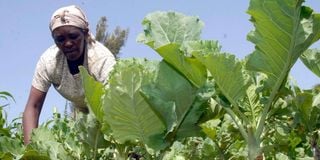Abandon the disastrous green revolution model

A farmer tends to her kales (sukuma wiki) crop in Ng'arua, Laikipia West.
Two significant events are taking place in East Africa this week. In Nairobi, the inaugural Africa Climate Summit has brought together heads of state and government to try to find a common voice ahead of COP28, while in Dar es Salaam, AGRA, which formally stands for Alliance for A Green Revolution in Africa, has gathered to "build better food systems and food sovereignty".
It is true that hunger and malnutrition have increased in Africa over the past decade, according to a report on global food security and nutrition by the Food and Agriculture Organisation.
From 2021 to 2022, the prevalence of undernourishment on the continent increased from 19.4 per cent to 19.7 per cent - or an additional 11 million people. Hunger also increased in all sub-regions of Africa over the past year, rising from 22.2 per cent in 2021 to 22.5 per cent in sub-Saharan Africa, or about nine million more people.
In Kenya, the number of undernourished people increased from 10.2 million in 2004-2006 to 14.7 million in 2020-2022, or 44 per cent, while the number of severely food insecure people increased from seven million in 2014-2016 to 14.8 million in 2020-2022.
While it is true that several factors are at play, including the Covid-19 pandemic and the Russia-Ukraine war, it should be noted that this trend started well before these two disasters and despite the work of groups such as the Alliance for a Green Revolution in Africa, now known simply as AGRA, and its supporters.
Struggle for survival
AGRA, which says its vision is "one where Africa can feed itself and the world by transforming agriculture from a solitary struggle for survival into a thriving business", has ignored the experience of smallholder farmers in favour of profit-driven industrial agriculture led by large corporations.
AGRA, which says its vision is 'one where Africa can feed itself and the world, transforming agriculture from a solitary struggle for survival into a thriving business', has ignored the experience of smallholder farmers in its championing of profit-driven industrial agriculture led by large corporations.
Founded in 2006, AGRA's goal was to bring high-yielding agricultural practices to some 30 million smallholder farmers, promising to double productivity, raise household incomes and cut food insecurity in half by 2020.
By that year, it had received about $1 billion in funding, most of it from the Bill and Melinda Gates Foundation, and disbursed more than $500 million in grants, mainly in 13 African countries it focuses on, according to a 2020 study by Timothy A. Wise of the Global Development and Environment Institute at Tufts University.
But while governments in the 13 countries have spent about $1 billion a year on subsidy programmes for the purchase of commercial seeds and fertiliser, the study found that little data on their impact has been made publicly available by AGRA, the Gates Foundation or the donor governments that support the initiative. In fact, an independent evaluation of AGRA commissioned by its donors in 2022 reported that AGRA had fallen short of its goals.
Moreover, as research by Tim Wise has shown, the industrial farming practices advocated by AGRA and others are degrading soils and reducing productivity.
Maize production
As Wise's study found, AGRA is not reaching a significant number of smallholder farmers. Maize productivity increased by only 29 per cent in 12 years, and the yields for a basket staple crops had risen by only 18 per cent over the same period.
According to the FAO, malnutrition has increased by 30 per cent in AGRA's focus countries.
However, under pressure from donors and big agribusiness, African countries continue to adopt policies that encourage these harmful agricultural practices.
But there is an alternative. In agroecology, farmers work with nature to promote the soil-enriching practices that new 'green' technologies undermine. Multiple food crops are grown in the same field, and compost and biofertilisers are used to enrich the soil.
Biological pest control reduces the use of inorganic pesticides. Farmers improve the productivity of their seeds with the help of researchers, eliminating the need to buy commercial seeds each year, which require fertiliser to grow. To do this, Kenyan farmers have set up Community Seed Learning Centres to select, save and distribute nutritious and high-yielding varieties of local food crops.
This farming method, which works with nature, has been proven to work.
The supporters of the Green Revolution currently meeting in Dar es Salaam should be brave enough to admit that their model has failed not just by taking the words 'green revolution' out of AGRA's name but by changing the substance of their approach as well. They should channel their resources to agroecology.
It is the least penance they can pay for the devastation they have wrought on the environment which has only starved and impoverished Africa.
Ms Maina is the National Coordinator, Biodiversity and Biosafety Association of Kenya
(BIBA-Kenya).




